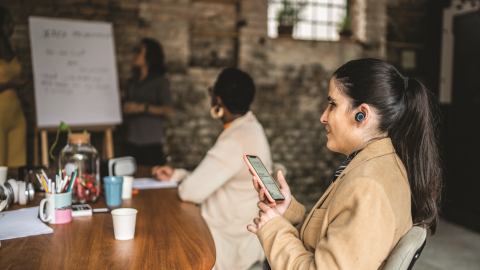What the disability community can teach us about working remotely
Over the last few weeks, the world at large has taken on many new challenges in daily life. Adopting new ways to work from home, often while parenting and balancing other priorities. It takes time, patience and problem solving. It’s like learning a new language.
We have received questions from across the disability community looking for tools, resources and best practices. Below you’ll see some of our key learnings since transitioning to working from home in early March. We have identified ways to accelerate the learning curve by leaning into our employees expertise and by continuing to prioritize accessibility to ensure that what we deliver is accessible to all our colleagues in these new and shifting circumstances.
Consider this the start of a series with more chapters ahead. Our hope is that by sharing these learnings we can accelerate your new your journey of being accessible, inclusive and productive – no matter where you’re working.
Learn from others with disabilities
The biggest source of knowledge right now are your employees, especially those in your disability employee communities. The insight and learning here will accelerate the learning curve. Three of our employees have already posted articles with details of how they are working day to day pragmatics:
- Leah Katz-Hernandez, a member of our CEO communications team, shares her experience as a profoundly deaf, visual-only American Sign Language (ASL) user – with tips on how to conduct great productive meetings in the virtual meeting space.
- Alyson Boote, a staff ASL interpreter, lists her recommendations for at-home remote ASL interpretation including downloadable reference guides.
- Megan Lawrence, member of our mental health employee resource group, details key tools and imperatives for maintaining emotional wellbeing including use of the toolset, MyAnalytics.
Leverage assistive technology
Now more than ever, accessibility isn’t option – it’s imperative. Online content, conference calls and virtual forums have replaced in person meetings and events for immediate future, and ‘in person’ accommodations that empower people with disabilities to consume that content have understandably reduced or stopped. However, if you embed accessibility into design of virtual or online content, you remove or reduce the potential of exclusion. You have the power to include and accessibility is the key. Here are a few tools at your disposal to assist you:
- Use Accessibility Insights to check your website, Windows or Android app for accessibility with quick easy guides on how to make them more accessible. Do this before you post content.
- Caption your videos. There are lots of ways to do this, I upload videos into Microsoft Stream (available as part of Microsoft 365) and auto captioning/editing feature prior to sharing within my organization.
- Use Accessibility Checker on any Microsoft 365 document to catch simple gotchas. Add alt-text to all images and ensure the format is screen reader friendly.
- Microsoft Teams is a one stop shop for conference calls, meetings, collaboration. If you’re looking for the simple answer to ‘is it accessible’ – yes – we’ve worked hard to making this an accessible platform for online meetings. Turn on live captions in any call or webinar, use ‘pin’ feature to keep one speaker (or in my case, my ASL interpreter) on the screen to avoid distractions, use Immersive Reader in the chat window or my favorite feature ‘background blur’ which was specifically designed by one of our deaf engineers to power up lipreading, great example of how an accessibility feature has powered up millions.
Contact us any time
The Microsoft Disability Answer Desk is available 24/7 by phone, chat or ASL Video. Please reach out if you need any advice or assistance as you learn your ‘new language.’
More to come. If you have any feedback or topics you want me to cover in next blog, pop ideas into the comments field below. Stay safe and wash your hands.








